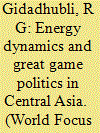|
|
|
Sort Order |
|
|
|
Items / Page
|
|
|
|
|
|
|
| Srl | Item |
| 1 |
ID:
138380


|
|
|
|
|
| Summary/Abstract |
Post-Soviet CA has become a victim of Great Game politics during the last two decades. Potentialities of energy sector CA has increased with Western investment, technology and market that brought dividends with huge inflow of petrodollars to Kazakhstan and Turkmenistan. But fluctuations of both in international prices for oil and gas and in global demand for energy have made a direct impact on economies of CA countries. Energy sector of CA is exposed to pipeline politics. There is realization of negative consequences of overdependence on energy sector. Lack of intra-regional cooperation has adversely affected Kyrgyzstan and Tajikistan
|
|
|
|
|
|
|
|
|
|
|
|
|
|
|
|
| 2 |
ID:
134137


|
|
|
|
|
| Publication |
2014.
|
| Summary/Abstract |
The recent geopolitical events, and primarily those unfolding along the West-Russia trajectory, have dramatically changed the forecast of how long the EU can continue using Russian energy resources. The European countries wish to slowly free themselves from their energy dependence on Russia and make new adjustments to the conceptual approaches to this problem. In particular, the EU has been actively fortifying its position in the Black Sea-Caspian Region by dividing it into two key strategic components-the Southern Caucasus and the Caspian.
The Eastern Partnership Program, which extends to Georgia, Ukraine, Azerbaijan, Moldova, Armenia, and Belarus, has implied close cooperation between these post-Soviet countries and the EU at all levels from the very beginning. The Europeans find these countries easier to understand in historical and cultural terms than the Central Asian countries.
The energy-rich countries (Azerbaijan, Turkmenistan, and Iran) and countries with considerable transit capacities (Turkey and Georgia) have found themselves in the epicenter of the European establishment's attention. At the beginning of 2014, several important new projects for the South Caucasian Region were articulated (Nabucco, Nabucco West, TAP, Shah Deniz-2, and others).
The EU is now faced with making an urgent choice between its former dependence on Russia or undertaking gradual modernization by finding new energy partners. In this respect, the most radical part of European society is willing to engage in any economically promising cooperation (in the form of low energy prices), as long as it is not with Russia or the U.S.
The rest of society holds a more moderate position in favor of diversifying suppliers; it is not against either Russian energy resources or American shale gas, but is also considering alternative energy sources.
It should be noted that, on the whole, the EU inclines more toward the second scenario.
However, after making its South Caucasian choice, the EU is not rushing to invest huge sums in the implementation of the energy projects that, as already noted, are being actively discussed by some countries of the region. Moreover, the American factor continues to play an important role: the U.S. is striving to squeeze Russia out of the European energy zone. In so doing, it is clearly striving to monopolize the European regional gas market.
|
|
|
|
|
|
|
|
|
|
|
|
|
|
|
|
| 3 |
ID:
126601


|
|
|
|
|
| Publication |
2013.
|
| Summary/Abstract |
This paper analyses the impact of postponing global mitigation action on abatement costs and energy systems changes in China and India. It compares energy-system changes and mitigation costs from a global and two national energy-system models under two global emission pathways with medium likelihood of meeting the 2 °C target: a least-cost pathway and a pathway that postpones ambitious mitigation action, starting from the Copenhagen Accord pledges. Both pathways have similar 2010-2050 cumulative greenhouse gas emissions. The analysis shows that postponing mitigation action increases the lock-in in less energy efficient technologies and results in much higher cumulative mitigation costs. The models agree that carbon capture and storage (CCS) and nuclear energy are important mitigation technologies, while the shares of biofuels and other renewables vary largely over the models. Differences between India and China with respect to the timing of emission reductions and the choice of mitigation measures relate to differences in projections of rapid economic change, capital stock turnover and technological development. Furthermore, depending on the way it is implemented, climate policy could increase indoor air pollution, but it is likely to provide synergies for energy security. These relations should be taken into account when designing national climate policies.
|
|
|
|
|
|
|
|
|
|
|
|
|
|
|
|
|
|
|
|
|